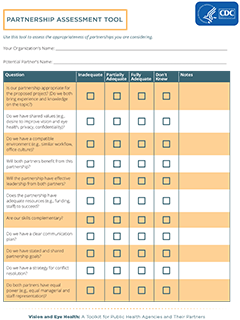Section 2: Identify, Formalize, and Sustain Partnerships
Identify Potential Partners
The first step to creating an effective partnership is to identify partners you can collaborate with to meet your goals.
Successful Partnerships:
- Have a clear purpose.
- Add value to the work of the partners.
- Are carefully developed to ensure that the partnership is valuable and sustainable.
Partnerships should include people with diverse skills who represent a range of perspectives and interests. For example, a partnership designed to improve vision and eye health might include people with vision impairment or loss, their caregivers, community members, representatives from the clinical care system, employers and businesses, media, nonprofit organizations, education, public health, aging services, and government organizations. When identifying potential partners, it can be helpful to think about those that are involved in program operations, those served or affected by the program, and those who are in a position to make decisions that could affect program sustainability. When looking for potential partners, consider the three major groups below.
- Management, program staff, and public health officials.
- Ophthalmologists, optometrists, nurses, and other healthcare providers.
- Partners, funding agencies, and coalition members.
- People affected by the problem (in this case, vision impairment or eye disorders).
- Advocacy groups.
- Community members.
- Elected officials.
- Funding agencies.
- Elected officials or other legislators.
- Members of the general public or taxpayers.
Consider The Following Questions as you Assess Potential Partners to Help Promote Vision and Eye Health Among Your Target Population:
- What is the expected outcome of the partnership?
- Which potential partners could best help you achieve your goals and objectives?
- Have you sought out new and nontraditional partners, such as organizations that serve people with disabilities or members of racial or ethnic minority groups?
- Do you have a history of good relations with the potential partner?
- Does the potential partner understand and support your priorities or have similar priorities?
- What specific resources will the potential partner contribute to the outcomes or products expected from the partnership?
- Could collaboration with the potential partner reduce costs or make the best use of resources?
- What are some potential drawbacks of working with the potential partner?
- Is there someone who will champion your cause and work to make sure the partnership happens?
Read more about formalizing the relationship and sustaining the partnership.
After an individual or organization has agreed to partner with you, you will need to formalize the relationship. One option is a written document, such as a partnership action plan or project charter. Written documents can outline the goals and objectives of the partnership and the roles and responsibilities of each partner.
A partnership action plan or project charter may also include:
- Agreed-upon decision-making procedures (who will decide what and how).
- Ground rules for effective ways of working together.
- Anticipated challenges and strategies for addressing them.
- Resources needed to accomplish the goals of the partnership.
Some organizations may be more comfortable formalizing the partnership through a memorandum of understanding, contract, or other form of written document. You can ask your organization’s legal department to create a more formal document if needed.
Partnerships must be actively maintained to help you meet your goals. To achieve this objective, you will need to:4
- Maintain regular communication with your partners. Decide when and how you will keep in touch (e.g., e-mail, phone).
- Respect your partner’s boundaries, structures, procedures, and processes.
- Thank your partner for their work through verbal or written comments.
- With your partner’s permission, give them credit and recognition in public forums, such as during meetings with key stakeholders or media outlets.
- Remain flexible and open to change throughout the partnership.
- Conduct a formal review of the partnership using an evaluation form that measures satisfaction with the partnership.
- Discuss and use the results of this evaluation to identify ways to strengthen the partnership.

Building partnerships is not always easy, and Chris Maylahn of the New York State Department of Health knows this firsthand. Chris knew he would need partners to qualify for a grant from CDC and Prevent Blindness to integrate vision and eye health with other state public health programs.
Read about this and other examples of successful partnerships.
Building effective partnerships is vital to creating and sustaining a successful intervention to improve vision and eye health in your community or target population. Taking the time to identify the right partners and thoughtfully develop a partnership will help ensure that the partnerships can be sustained over time.
- Next Section 3: Implement Interventions to Improve Vision and Eye Health describes how you and your partners can identify and implement interventions to improve vision and eye health.


